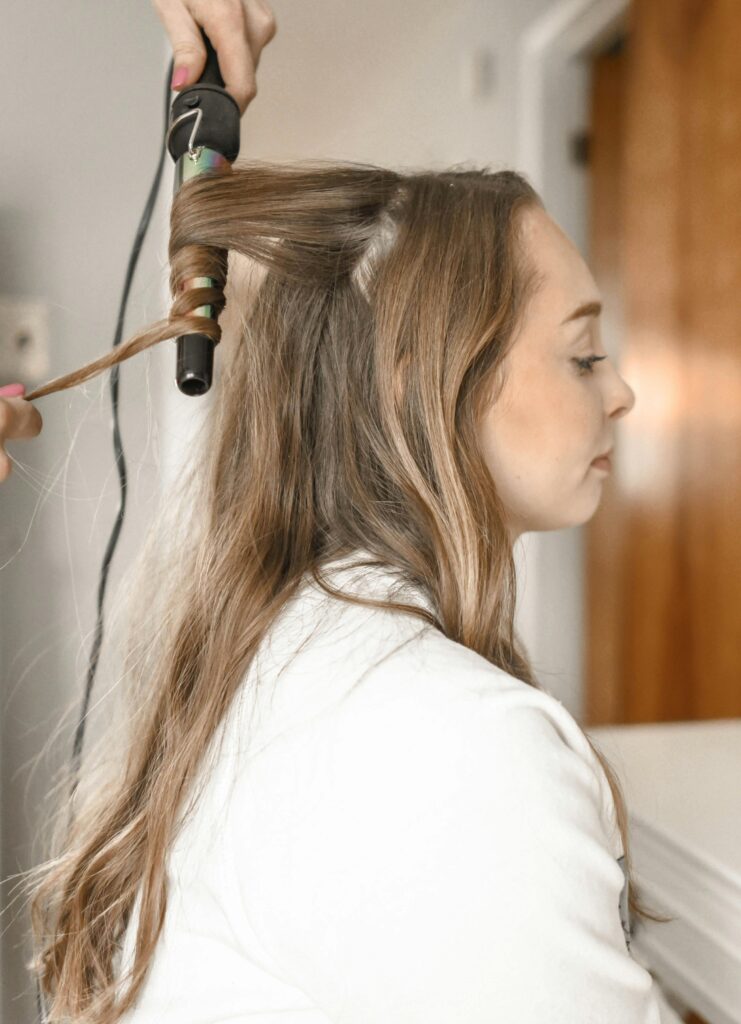What Does it Mean to Become a Freelance Hairstylist?
What Does it Mean to Become a Freelance Hairstylist?
In this article we’re going to talk about the ins and outs of what it takes to become a fully self-employed and creative freelance hairstylist! Below are the pros and cons, and all of the tips you need to know to become a successful freelance hair professional yourself!

Embarking on the journey of becoming a freelance hairstylist is a significant career shift for many in the beauty industry.
Unlike traditional salon employees, freelance hairstylists operate independently, providing services to clients without being tied to a single salon.
This freedom allows hairstylists to set their schedules, choose their clients, and offer personalized services in various settings, such as clients’ homes, special events, or rented salon spaces.
Being a freelance hairstylist means taking on multiple roles, including –
- Marketer
- Manager
- Accountant
- All while honing one’s craft and building a loyal client base
What is a Freelance Hairstylist?
A freelance hairstylist is a self-employed professional who offers hairdressing services independently of any salon or beauty establishment.
Freelance hairstylists have the autonomy to create their brand, set their prices, and tailor their services to meet the unique needs of their clients.
They can also work in various locations, including clients’ homes, pop-up salons, or shared co-working spaces designed for beauty professionals.
Can a Hairstylist be Freelance?
Absolutely! Many professionals in the beauty industry opt for freelance work to gain more control over their careers. This path allows hairstylists to build a flexible schedule, pursue creative projects, and diversify their income streams. Freelancing can be an ideal choice for hairstylists who want to offer personalized services, engage directly with their clientele, and develop a unique brand identity.

What are Some Things I can do to Become a Successful Freelance Hairstylist?
- Build a Strong Portfolio: Showcase your best work through a well-curated portfolio. This can include before-and-after photos, client testimonials, and examples of various hairdressing techniques. A strong portfolio can attract potential clients and demonstrate your expertise.
- Develop a Personal Brand: Create a unique brand that reflects your style and professional values. This includes designing a logo, creating business cards, and maintaining a consistent presence across social media platforms (a good thing but not 100% necessary. You don’t have to be Instagram famous to be an excellent freelance hair professional). A strong brand helps you stand out in a competitive market.
- Network with Industry Professionals: Build relationships with other beauty professionals, including makeup artists, photographers, and event planners. Networking can lead to referrals and collaborative opportunities that expand your client base.
- Invest in Continuous Education: Stay updated with the latest trends and techniques in hairdressing. Attend workshops, take online courses, and participate in industry events to enhance your skills and stay competitive.
- Utilize Technology: Leverage appointment scheduling software, accounting tools, and social media platforms to streamline your business operations. Efficient use of technology can improve client communication, manage bookings, and track financials.
10 Benefits (Pros) of Becoming a Freelance or Self-Employed Hairdresser

- Flexibility: Set your schedule and work at times that suit you and your clients.
- Autonomy: Make independent decisions about your services, pricing, and business operations.
- Creative Freedom: Pursue creative projects and experiment with new styles and techniques without salon restrictions.
- Higher Earning Potential: Set your rates and potentially earn more than a salaried salon position.
- Diverse Work Environments: Work in various settings, including clients’ homes, events, and different rental spaces.
- Client Relationships: Build stronger, more personalized relationships with your clients.
- Brand Building: Develop and grow your unique brand, enhancing your professional reputation.
- Networking Opportunities: Collaborate with other freelancers and industry professionals.
- Personal Satisfaction: Enjoy the satisfaction of running your own business and achieving personal and professional goals.
- Variety in Work: Experience a wide range of clients and hairdressing challenges, keeping the work dynamic and engaging.
What are the Challenges (Cons) of Being a Self-Employed Hairdresser?
- Financial Instability: Income can be unpredictable, especially when starting.
- No Employee Benefits: Lack of health insurance, paid leave, and other benefits typically provided by employers.
- Increased Responsibility: Managing all aspects of the business, including marketing, accounting, and client management.
- Initial Investment: High upfront costs for equipment, products, and marketing materials.
- Isolation: Working independently can sometimes feel lonely compared to the camaraderie of a salon environment. Butthis entirely depends on where and how you end up getting your business set up.
- Self-Motivation Required: Success depends heavily on your ability to stay motivated and disciplined.
- Administrative Work: Balancing creative work with administrative tasks can be challenging.
- Client Dependence: Building and maintaining a steady client base requires ongoing effort and excellent customer service.
- Limited Resources: Access to advanced tools and products may be more limited compared to a fully equipped salon.
- Market Competition: Standing out in a saturated market requires significant effort in branding and marketing.
Do You Need an Accountant, Website, Appointment Software? How Important are These?
Accountant: Hiring an accountant is highly beneficial for managing finances, handling taxes, and ensuring compliance with financial regulations. An accountant can help you maximize deductions, plan for tax payments, and provide financial advice.
Website: A professional website is essential for showcasing your portfolio, listing services, and providing contact information. It serves as an online hub for potential clients to learn about your work and book appointments.
Appointment Software: Utilizing appointment scheduling software streamlines the booking process, reduces administrative work, and improves client communication. It allows clients to book services at their convenience and sends reminders to minimize no-shows.
Investing in these tools and services can significantly enhance your business’s efficiency, professionalism, and client satisfaction.
How to Become a Freelance Hairstylist?

What are Some Business Tips to Get Set Up as a Hairstylist?
- Obtain Necessary Licenses and Certifications: Ensure you have the required hairstyling licenses and certifications for your area.
- Create a Business Plan: Outline your business goals, target market, pricing structure, and marketing strategies.
- Set Up a Legal Structure: Choose a business structure (e.g., sole proprietorship, LLC) and register your business name.
- Open a Business Bank Account: Keep your personal and business finances separate by opening a dedicated business bank account.
- Invest in Quality Tools and Products: Purchase professional-grade hairstyling tools and products to provide high-quality services.
- Develop a Marketing Strategy: Utilize social media, create a website, and network with industry professionals to promote your services.
- Offer Promotions and Discounts: Attract new clients by offering introductory promotions or referral discounts.
- Build a Client Base: Maintain a database of client contact information, preferences, and appointment history to personalize your services. This can be your appointment software or just your personal mobile device.
What are Some Steps of Starting a Freelance Business?
- Research and Planning: Conduct market research to understand the demand for freelance hairstyling in your area and plan your services accordingly.
- Legal Considerations: Obtain necessary licenses, choose a business structure, and register your business.
- Financial Planning: Set a budget, open a business bank account, and consider hiring an accountant.
- Brand Development: Create a brand identity, design a logo, and develop marketing materials.
- Set Up Operations: Purchase tools, set up an appointment booking system, and establish a workspace if needed.
- Marketing and Promotion: Launch a website, create social media profiles, and start promoting your services.
- Client Acquisition: Network, offer promotions, and provide excellent customer service to build a loyal client base.
What do I Have to Have on Hand to Start My Freelancing Business?

- Professional Hairstyling Tools: Scissors, combs, brushes, hairdryers, straighteners, and curling irons.
- Quality Hair Products: Shampoos, conditioners, styling products, and hair color kits.
- Appointment Scheduling Software: A system to manage bookings and client information.
- Marketing Materials: Business cards, flyers, and promotional materials.
- Financial Tools: Accounting software or an accountant to manage finances.
- Online Presence: A professional website and active social media profiles.
- Workspace: A clean, organized space for providing services if not working on-site.
How to Find Work as a Freelance Hairdresser
- Leverage Social Media: Use platforms like Instagram, Facebook, and Pinterest to showcase your work, engage with potential clients, and network with industry professionals.
- Join Freelance Platforms: Sign up on freelance job sites and beauty industry platforms to find job opportunities and connect with clients.
- Network Locally: Attend local events, join beauty industry groups, and collaborate with other professionals to gain referrals.
- Offer Promotions: Attract new clients with special offers, discounts, or referral incentives.
- Request Reviews and Referrals: Encourage satisfied clients to leave positive reviews online and refer your services to others.
How to Handle Taxes as a Freelancer
- Keep Accurate Records: Maintain detailed records of all income and expenses related to your business.
- Understand Tax Deductions: Familiarize yourself with tax deductions available to self-employed individuals, such as expenses for tools, products, and travel.
- Pay Estimated Taxes: Since you won’t have taxes automatically deducted from your income, you’ll need to pay estimated taxes quarterly to the IRS and possibly your state’s tax agency.
- File Self-Employment Tax: In addition to income tax, you’ll need to pay self-employment tax, which covers Social Security and Medicare contributions.
- Consult a Tax Professional: Consider hiring an accountant or tax advisor who specializes in self-employment to ensure you’re compliant with tax laws and maximizing deductions.
Working in a Salon vs. Freelance Hairstylist
Salon:
- Stability: Provides a stable work environment with a steady flow of clients.
- Benefits: Often includes employee benefits like health insurance, paid time off, and retirement plans.
- Structure: Offers a structured schedule and support from colleagues and management.
- Limited Autonomy: Less control over services offered, pricing, and work hours.
- Shared Revenue: Income is often a combination of salary and commission, with a portion going to the salon.
Freelance:
- Flexibility: Set your schedule and choose your clients.
- Autonomy: Full control over pricing, services, and branding.
- Earning Potential: Potential for higher income through direct client payments.
- Responsibilities: Must manage all aspects of the business, including marketing, scheduling, and finances.
- Investment: Initial costs for tools, products, and marketing are self-funded.
FAQs for How to Become a Freelance Hairstylist

Can a Hairstylist be Freelance?
Yes, hairstylists can work independently as freelancers. This allows them to offer their services directly to clients without being tied to a single salon. Freelance hairstylists enjoy flexibility, autonomy, and the potential for higher earnings but also face the challenges of managing their own business operations.
How to Run a Salon with Self Employed Staff
- Clear Agreements: Establish clear contracts outlining the terms of the relationship, including rent, commissions, and responsibilities.
- Shared Resources: Provide essential resources like salon chairs, styling stations, and products, while allowing self-employed staff to bring their tools.
- Flexible Scheduling: Offer flexible scheduling to accommodate the independent nature of self-employed stylists.
- Marketing Support: Assist with marketing efforts to attract clients and fill appointment slots.
- Professional Environment: Maintain a professional, clean, and welcoming environment that supports the success of all stylists.
What’s the Salary, on Average, of a Self Employed Hairstylist?
The salary of a self-employed hairstylist can vary widely based on location, clientele, and pricing. On average, a self-employed hairstylist can earn anywhere from $25,000 to $70,000 or more per year. Successful stylists in high-demand areas or those with a strong client base can earn significantly more. Factors such as the number of clients, services offered, and overhead costs will influence earnings.
What’s a Self Employed Barber?
A self-employed barber operates independently, providing hair cutting and grooming services without being tied to a specific barbershop. Like freelance hairstylists, self-employed barbers have the freedom to set their schedules, choose their clients, and offer personalized services. They are responsible for managing their business operations, including marketing, booking appointments, and handling finances. Self-employed barbers can work in various settings, including home studios, rented barber stations, or on-site services for clients.
Related Articles to How to Become a Freelance Hairstylist
A Guide for a Solid Salon Suite Business Plan – Free Templates
24 Add On Services to Make your Salon Unique
How to Get More Clients as a Hairstylist – 12 Tips from Experience
Professional Hairstylist Networking Tips
Are Salons Recession Proof? How to Make Your Salon Immune
Salon Suite vs Booth Rent – Which is Best for You?
How to Build a Clientele as an Independent Hairstylist
35 Unique Salon Service Ideas to Make your Salon Stand Out

